 Petzlover
Petzlover Miniature Dachshund is originated from Germany but Mudi is originated from Hungary. Miniature Dachshund may grow 29 cm / 11 inches shorter than Mudi. Miniature Dachshund may weigh 9 kg / 19 pounds lesser than Mudi. Miniature Dachshund may live 3 years more than Mudi. Miniature Dachshund may have less litter size than Mudi. Miniature Dachshund requires Low Maintenance. But Mudi requires Moderate Maintenance
Miniature Dachshund is originated from Germany but Mudi is originated from Hungary. Miniature Dachshund may grow 29 cm / 11 inches shorter than Mudi. Miniature Dachshund may weigh 9 kg / 19 pounds lesser than Mudi. Miniature Dachshund may live 3 years more than Mudi. Miniature Dachshund may have less litter size than Mudi. Miniature Dachshund requires Low Maintenance. But Mudi requires Moderate Maintenance
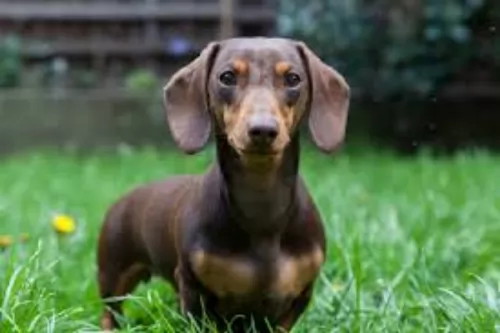 The Dachshund breed is ancient and was developed in Germany sometime around the 16th century.
The Dachshund breed is ancient and was developed in Germany sometime around the 16th century.
It was in 1870 that Dachshunds first came to the United States to be used for hunting. During the 19th century, German hunters wanted smaller dachshunds.
The Dachshund was crossed with toy terriers. The coat comes in three coats – smooth-, long-haired and wire-haired. There is just one size of Miniature Dachshund in the UK and the United States.
 Sometime between the 4th and 6th centuries, the Great Migration – a variety of dogs came to live in the Carpathian Mountains on the Great Hungarian Plain. This migration period brought sheepdogs and herders brought by shepherds. These dogs were of two sizes both small and large. The smaller ones were bred together – Pumi, Puli, and Mudi. Because of this, these breeds share the same history, with the Mundi being the oldest of them all.
Sometime between the 4th and 6th centuries, the Great Migration – a variety of dogs came to live in the Carpathian Mountains on the Great Hungarian Plain. This migration period brought sheepdogs and herders brought by shepherds. These dogs were of two sizes both small and large. The smaller ones were bred together – Pumi, Puli, and Mudi. Because of this, these breeds share the same history, with the Mundi being the oldest of them all.
The Mundi was finally separated from the other breeds about 1930 when Dr. Deszo Fenyesi began to breed them. It was in 1966 when the F.C.I. finally approved the standard for the breed. Still then as today, there were not many breeders developing the Mudi. They are working dogs – farm dogs – herders, guard dogs and ratters. He is also known as a tracker, with the majority of the breed living in Hungary.
As the Mudi was bred separately from the Pumi and the Puli, differences between the breeds became clear. Many Mudi are born with a stump or no tail at all. The Mudi is not a great dog for the first timer. He is stubborn, assertive and needs a lot of socialization and exercise. In 2004 breeders in the United States created the Mudi Club of America to preserve the breed and foster responsible ownership. This is a clever, active and keen breed, very loyal to his family but wary of strangers. The United Kennel Club recognized the breed in 2006.
In Hungary, these are still a breed of herding dogs capable of running 500 sheep at a time. They are versatile, courageous, intelligent and agile. They are great in obedience trials, agility, and flyball. In Finland and the United States, they also work as search and rescue dogs.
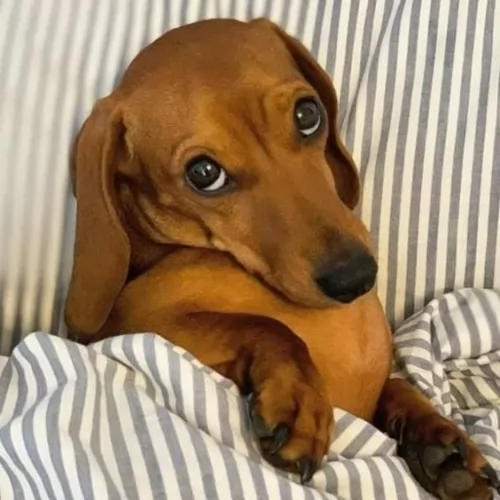 Coming in a range of colors such as red, black, black and tan, cream, chocolate etc, the coat of the Miniature Dachshund can be long or short. Both male and females stand at between 13 – 18cm and weigh between 3 and 5kg.
Coming in a range of colors such as red, black, black and tan, cream, chocolate etc, the coat of the Miniature Dachshund can be long or short. Both male and females stand at between 13 – 18cm and weigh between 3 and 5kg.
These dogs are characterized by the long back and very short legs with floppy ears and a long tail. The face is always bright and alert.
The Miniature Dachshund is a small dog and can happily adapt to life in the city as well as in the countryside. This is because with their exercise needs, they don’t require a huge garden but can in fact, exercise indoors.
They’ve always been bred to hunt and are independent and feisty. They’re also intelligent and will do well with training and socialization.
They are also devoted to their families and are known to bark when strangers come near their family. They’ve got a lot of energy and just love being involved with games or going on a walk. Consider him when going on a walk though as his little legs have to take many more steps as compared to your one step.
They can be stubborn, but are friendly, lovable little pets, they aren’t suited for homes with toddlers unless the children have been taught to be exceedingly gentle and kind with animals, especially small, fragile ones like this. They can so easily get hurt.
 This is a medium size dog with an almost square profile. They have erect ears on wedge-shaped heads. He is not a strong boned but medium boned. That square profile is based in large part on their very square stance. Their muzzle is about half the length of their head and they have what is considered a “dare devil” expression in their dark, almond-shaped eyes. The color of the eyes is important and must match with the color of the dog or the standard is not met.
This is a medium size dog with an almost square profile. They have erect ears on wedge-shaped heads. He is not a strong boned but medium boned. That square profile is based in large part on their very square stance. Their muzzle is about half the length of their head and they have what is considered a “dare devil” expression in their dark, almond-shaped eyes. The color of the eyes is important and must match with the color of the dog or the standard is not met.
Merle fur – brown, brown speckled, blue eyes.
Brown or gray-brown fur – Brown eyes
Gray fur – gray eyes
What is not acceptable is having yellow eyes and black fur; pink eyes and white fur. The lips, eye rims, and nose must all have the same pigmentation. This should be black in all but the brown and brown-grey dogs. These dogs have brown noses, eye rims, and lips. The tail can be almost anything from full to bob. All are considered to be natural lengths for a Mudi.
Their coat is self-cleaning and won’t mat. It is on the long side. In fact, a short, flat, smooth coat is a disqualification from the standard. The color of the coat ranges from white to brown to gray, gray-brown, merle, golden, cream and white. Very little markings of any kind are usual.
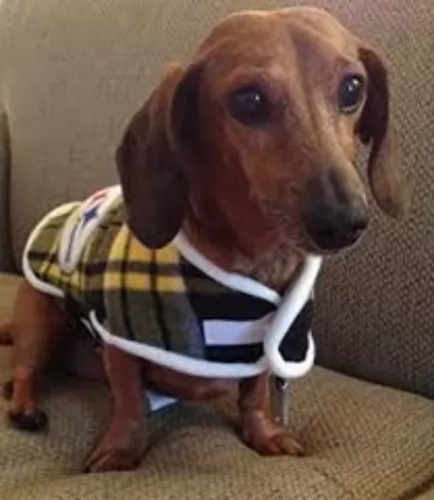 The Miniature Dachshund has lots of qualities which make him such a splendid pet. He is intelligent, brave, bold and loyal with his human family.
The Miniature Dachshund has lots of qualities which make him such a splendid pet. He is intelligent, brave, bold and loyal with his human family.
He is fun-loving and energetic and thrives on lots of games and walks. He is versatile in nature and also loves to take things easy indoors with his family.
These little dogs form strong bonds with their family and don’t like to be left on their own. When you have one of these as a pet you’re allowing a whole lot of joy into your home.
 Yes, they are great with children and love being a part of a large family or “pack”.
Yes, they are great with children and love being a part of a large family or “pack”.
They are extremely versatile and great at herding and guarding.
They are adaptable if you are. They don’t need to live in the country, but they need space to run and play.
They are highly intelligent but a little stubborn. Their ability to learn is high but you have to be the boss.
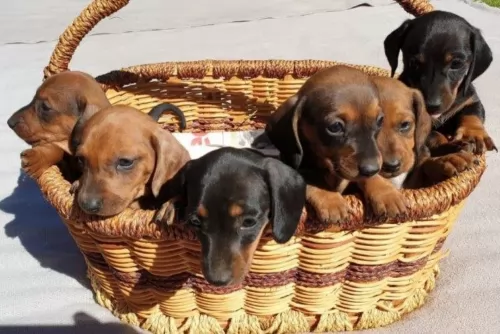 Be very careful with the Miniature Dachshund because of their long backs. You don't want to be allowing him to be jumping off chairs etc as their backs are prone to injury. To solve the problem you can buy special stairs and ramps for small dogs.
Be very careful with the Miniature Dachshund because of their long backs. You don't want to be allowing him to be jumping off chairs etc as their backs are prone to injury. To solve the problem you can buy special stairs and ramps for small dogs.
They can live to be between 12 and 14 years of age when looked after well.
A disease that is fairly common in the Miniature Dachshund is Intervertebral Disc Disease, a condition where the cushioning discs between the vertebrae of the spinal column bulge or burst into the spinal cord space, pressing on the nerves and causing nerve damage and worse, paralysis.
 The Mudi does face several of the problems that medium to large dogs often face and some eye issues as well.
The Mudi does face several of the problems that medium to large dogs often face and some eye issues as well.
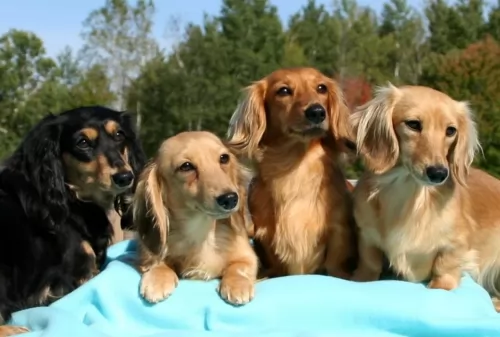 Dachshunds can put on weight quickly and you want to avoid this at all costs as extra weight can put strain on the back.
Dachshunds can put on weight quickly and you want to avoid this at all costs as extra weight can put strain on the back.
If you feed your Mini Dachshund commercially manufactured dog food, choose the best quality ones, high in vitamins and minerals and avoid some of the cheaper ones that use unwholesome fillers, colorants, sugar and lots of salt, all of which can be toxic for your pet.
Of course home-made food is always best, but not any foods either. It is best with any dog to keep their foods simple and consistent so as to avoid stomach problems. Chopped up boiled chicken, brown rice or pasta and some cooked vegetables such as potatoes carrots and spinach will do wonders for him. Make sure that there is a constant supply of fresh, cool water for him.
A good brush of the coat twice a week will do fine for your Miniature Dachshund. Remember to check him over for fleas and ticks when you brush him and to feel for any unusual lumps. Keep the nails trimmed.
Check both eyes and ears for infection. There are ways to keep the inside of long eared dog breeds clean and dry, but if you’re unsure there are always professional groomers who will do the job for you, and clean their teeth at the same time. You can brush your dogs teeth 2 or 3 times a week to avoid plaque build up, gum infection and tooth loss.
 The Mudi needs a high quality, medium breed puppy dry food and should be fed 3 or 4 times a day for a total of 1 and ½ to 2 cups.
The Mudi needs a high quality, medium breed puppy dry food and should be fed 3 or 4 times a day for a total of 1 and ½ to 2 cups.
The adult should be fed at least twice a day with an adult medium breed high-quality dry dog food. Don’t overfeed as the breed can have a tendency toward obesity.
They have great stamina and agility.
This is a working dog and like most herding dogs, they need a job and a lot of activity. Long walks every day and either a large yard or visits to a dog park. Involve them in herding activities or Barn Hunt if you can. Playing is their way of working when they are not herding real animals. So, if you want this breed, be sure you have time for playing with them. They are great at agility, flyball, obedience, frisbee trials, tracking and of course herding